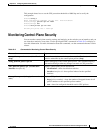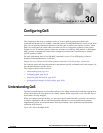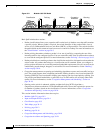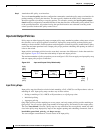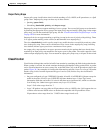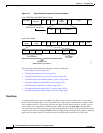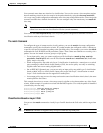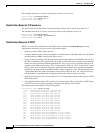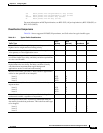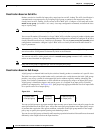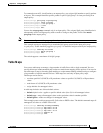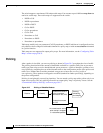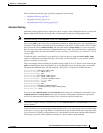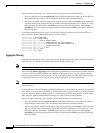
30-7
Cisco ME 3400 Ethernet Access Switch Software Configuration Guide
78-17058-01
Chapter 30 Configuring QoS
Understanding QoS
You can match more than one criterion for classification. You can also create a class map that requires
that all matching criteria in the class map be in the packet header by using the class map match-all
class-map name global configuration command to enter class map configuration mode. A class map with
no match condition has a default of match all. You can configure only one match entry in a match-all
class map.
Note If you do not enter match-all or match-any, the default is to match all. A match-all class map
cannot have more than one classification criterion (match statement).
You can use the class map match-any class-map name global configuration command to define a
classification with any of the listed criteria.
The match Command
To configure the type of content used to classify packets, you use the match class-map configuration
command to specify the classification criteria. If a packet matches the configured criteria, it belongs to
a specific class and is forwarded according to the specified policy. For example, you can use the match
command with CoS, IP DSCP, and IP precedence values. These values are referred to as markings on a
packet. You can also match an access group or a QoS group.
• For an input policy map, you cannot configure an IP classification (match ip dscp, match ip
precedence, match ip acl) and a non-IP classification (match cos or match mac acl) in the same
policy map or class map.
• When an input policy map with only Layer 2 classification is attached to a routed port or a switch
port containing a routed switch virtual interface (SVI), the service policy acts only on switching
eligible traffic and not on routing eligible traffic.
• On an IEEE 802.1Q tunnel port, you can use only an input policy map with Layer 2 classification
based on MAC ACLs to classify traffic. Input policy maps with Layer 3 classification or match
Layer 2 CoS classification are not supported on tunnel ports.
• In an output policy map, no two class maps can have the same classification criteria, that is, the same
match qualifiers and values.
This example shows how to create a class map example to define a class that matches any of the listed
criteria. In this example, if a packet is received with the DSCP equal to 32 or a 40, the packet is identified
(classified) by the class map.
Switch(config)# class-map match-any example
Switch(config-cmap)# match ip dscp 32
Switch(config-cmap)# match ip dscp 40
Switch(config-cmap)# exit
Classification Based on Layer 2 CoS
You can use the match command to classify Layer 2 traffic based on the CoS value, which ranges from
0 to 7.
Note A match cos command is supported only on Layer 2 IEEE 802.1Q trunk ports.



